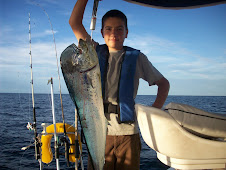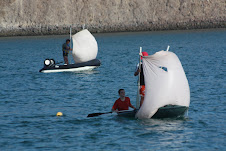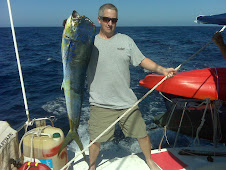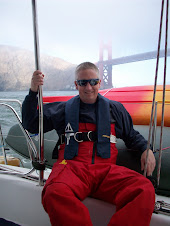
We are still stuck awaiting repairs and there’s nothing of much interest going on, so I’ll take this opportunity to do a blog or two that could be helpful to all those potential cruisers at home who are either dreaming or actively working on getting out here.
One of the things I have been most surprised at over the last two and half years has been the evolution of my relationship with our SSB (single side band radio). In my land-based life I didn’t even know there was such a thing or what it would be used for. Now it is an integral part of our daily life and I cannot imagine cruising without one. It plays several vital roles - it’s one of the major pieces of safety equipment on board; helps us keep track of friends who are spread out over hundreds of miles; it provides great entertainment; it’s our primary weather source; and it sends and receives emails from what some of you guys on land like to call “The Real World”. All in one piece of equipment and we haven’t even been using all its functions. We can also receive weather fax GRIB files, broadcast on Ham radio frequencies, and listen to AM radio. I wouldn’t be surprised to find out there are other uses that I don’t even know about.
When we were still on land trying to figure out what we needed to cruise, we debated the SSB issue for some time. Not everyone has one, or they have cheaper units that can receive signals, but not transmit. It’s pretty expensive at a thousand or two, to buy and install one that transmits and receives. We finally decided that it would be good from a safety standpoint to have one so that we would have a chance to contact the outside world in a true emergency. Though that is still an important function, our SSB is used for so much more.
Every day when we are out in the anchorages, we listen to at least one of three SSB radio nets that run seven days a week - the Amigo Net and Sonrisa Net in the morning and the Southbound Net at night. Each of those nets provides weather and check-ins for boats in the Mexico area so you can find out who is where, what weather conditions are like there, and hear about any big fish caught or other news-worthy announcements (breakdowns, thefts, good restaurants). All in all, it’s pretty entertaining (and educational!) to listen to the nets and they have come to take the place of TV shows in our life. It’s Days Of Our Lives without the visuals. Except in this soap opera/comedy-drama, you can take a part, ad-lib your own lines and participate. Even better, you get to meet the show’s characters out in the anchorages.
When we first started, we were only “lurkers” on the marine radio nets - the silent multitude who abstain from participating but who listen. In a few weeks, Patrick was comfortable enough to do our ship’s first check-in on a marine radio net. I felt brave enough to grab the mike and check-in JaM after about six months. By then, Patrick had volunteered to be a Net Controller for the Southbound net once a week. It was another six months or so before I became a Net Controller for the Amigo Net once per week. Think of the net controller like the TV Game Show Host; they set the tempo of the Net and keep it rolling smoothly along, making sure everyone who wants gets a chance to check-in and they contact the weather man and take the weather. Somewhere along the way we began listening to nets (like Sonrisa) run on the Ham radio frequencies, but since neither of us had ham licenses we were unable to speak, just listen.
The email function of the SSB has been one of the only ways we’re able to keep in contact with our family and friends when we were out in anchorages far from internet or phone access. I still don’t know how it works but you can type up an email on your computer, hook your computer to your SSB and then send your written words out over the radio waves to someone’s internet email account. I think it’s magic so I don’t question it, I just do it. It’s brilliant.
But now, I’ve just completed the steps to access another feature of our SSB - the ham radio. Last month I took the ham radio test in La Paz. I’ve been waiting months to be in the right place at the right time to take the ham test. To broadcast on ham frequencies, you need a ham license which means you have to pass some tests. I haven’t crammed for a test in a long time and was very happy to find out that my brain still works pretty much like it used to, despite being sun-baked in a beer sauce for a couple years. You have to assimilate a lot of information about radio frequencies, propagation, radio equipment, and electricity - things which I have never had a clue about. But happily I crammed for a week, and managed to pass both the Technician class test and the General class test, making me eligible to participate in the Sonrisa net and a lot of other nets (but not Patrick - hee hee hee). The Ham radio nets open the door to an even bigger and cooler network of people. The hamsters tend to be a little more serious, long-term, and experienced cruisers. All things I would like to be.
Though I had no idea how important the SSB would become in my life back then, I can honestly tell you that buying one was one of the best decisions we made in that frantic two weeks of outfitting the boat. We chose an ICOM IC-M700PRO. It’s a larger unit than many, but we had the room for it at our Navigation Station and the larger size just means that it’s cheaper to buy since everyone wants the sleek little ones. I’m sure there are even more choices on the market now. So in conclusion, when you’re getting ready for your cruise, investigate getting an SSB. The longer you are planning to be out, and the more remote places you are going, the more useful it would be. If you decide to get one, then while you’re at - get your ham license now. It’s hard to find a test out here!
One of the things I have been most surprised at over the last two and half years has been the evolution of my relationship with our SSB (single side band radio). In my land-based life I didn’t even know there was such a thing or what it would be used for. Now it is an integral part of our daily life and I cannot imagine cruising without one. It plays several vital roles - it’s one of the major pieces of safety equipment on board; helps us keep track of friends who are spread out over hundreds of miles; it provides great entertainment; it’s our primary weather source; and it sends and receives emails from what some of you guys on land like to call “The Real World”. All in one piece of equipment and we haven’t even been using all its functions. We can also receive weather fax GRIB files, broadcast on Ham radio frequencies, and listen to AM radio. I wouldn’t be surprised to find out there are other uses that I don’t even know about.
When we were still on land trying to figure out what we needed to cruise, we debated the SSB issue for some time. Not everyone has one, or they have cheaper units that can receive signals, but not transmit. It’s pretty expensive at a thousand or two, to buy and install one that transmits and receives. We finally decided that it would be good from a safety standpoint to have one so that we would have a chance to contact the outside world in a true emergency. Though that is still an important function, our SSB is used for so much more.
Every day when we are out in the anchorages, we listen to at least one of three SSB radio nets that run seven days a week - the Amigo Net and Sonrisa Net in the morning and the Southbound Net at night. Each of those nets provides weather and check-ins for boats in the Mexico area so you can find out who is where, what weather conditions are like there, and hear about any big fish caught or other news-worthy announcements (breakdowns, thefts, good restaurants). All in all, it’s pretty entertaining (and educational!) to listen to the nets and they have come to take the place of TV shows in our life. It’s Days Of Our Lives without the visuals. Except in this soap opera/comedy-drama, you can take a part, ad-lib your own lines and participate. Even better, you get to meet the show’s characters out in the anchorages.
When we first started, we were only “lurkers” on the marine radio nets - the silent multitude who abstain from participating but who listen. In a few weeks, Patrick was comfortable enough to do our ship’s first check-in on a marine radio net. I felt brave enough to grab the mike and check-in JaM after about six months. By then, Patrick had volunteered to be a Net Controller for the Southbound net once a week. It was another six months or so before I became a Net Controller for the Amigo Net once per week. Think of the net controller like the TV Game Show Host; they set the tempo of the Net and keep it rolling smoothly along, making sure everyone who wants gets a chance to check-in and they contact the weather man and take the weather. Somewhere along the way we began listening to nets (like Sonrisa) run on the Ham radio frequencies, but since neither of us had ham licenses we were unable to speak, just listen.
The email function of the SSB has been one of the only ways we’re able to keep in contact with our family and friends when we were out in anchorages far from internet or phone access. I still don’t know how it works but you can type up an email on your computer, hook your computer to your SSB and then send your written words out over the radio waves to someone’s internet email account. I think it’s magic so I don’t question it, I just do it. It’s brilliant.
But now, I’ve just completed the steps to access another feature of our SSB - the ham radio. Last month I took the ham radio test in La Paz. I’ve been waiting months to be in the right place at the right time to take the ham test. To broadcast on ham frequencies, you need a ham license which means you have to pass some tests. I haven’t crammed for a test in a long time and was very happy to find out that my brain still works pretty much like it used to, despite being sun-baked in a beer sauce for a couple years. You have to assimilate a lot of information about radio frequencies, propagation, radio equipment, and electricity - things which I have never had a clue about. But happily I crammed for a week, and managed to pass both the Technician class test and the General class test, making me eligible to participate in the Sonrisa net and a lot of other nets (but not Patrick - hee hee hee). The Ham radio nets open the door to an even bigger and cooler network of people. The hamsters tend to be a little more serious, long-term, and experienced cruisers. All things I would like to be.
Though I had no idea how important the SSB would become in my life back then, I can honestly tell you that buying one was one of the best decisions we made in that frantic two weeks of outfitting the boat. We chose an ICOM IC-M700PRO. It’s a larger unit than many, but we had the room for it at our Navigation Station and the larger size just means that it’s cheaper to buy since everyone wants the sleek little ones. I’m sure there are even more choices on the market now. So in conclusion, when you’re getting ready for your cruise, investigate getting an SSB. The longer you are planning to be out, and the more remote places you are going, the more useful it would be. If you decide to get one, then while you’re at - get your ham license now. It’s hard to find a test out here!
















Been reading you guys for awhile now. Have to add my two cents worth. Great on the Ham ticket and don't stop with the Tech. The Extra really opens the whole batch. Please mention the new call so we outthere can listen for you. Oh yes this is Guy Driver WR7K and the brother of Dick. and am another who should of would of could of about sailing south and turning right somewhere down south. Oh well can't figure out how to do it at this point. Except through you and the others who share their stuff on the web...thanks
ReplyDeleteguy and 73
I hope my first comment came through. I will have to check out the two nets you mentioned and see how the propagation is from eastern Washington. Your new call??
ReplyDelete73 guy wr7k
Well Hi!
ReplyDeleteThanks for your kinds words. My call sign is KF7PBX. Since we are in the La Paz area I have not been checking into the nets because of the radio interference from the city and all the masts/boats/gemerators close together. No one can hear me. But when we get out in the anchorages, I'll start checking in them. It would be fun to say "Hi"
73
Laura
I like your article about your experience about SSB radio.
ReplyDeleteAnd for all, they don´t know which frequency is the best use the " Where and When " Propagation tool from the website: http://where-and-when.yachtfunk.com.
fair winds
joerg S/V harrier
Thanks for supplying more info for the readers.
DeleteLaura